Splendors you never have dreamed all your days— my lucky friends! With spooky season upon us, you’ll have your pick— there seems to be a Sweeney in every market this October! Live in or around Frederick and that side of the state? Other Voices Theatre has got your covered with their production of Stephen Sondheim’s Sweeney Todd: The Demon Barber of Fleet Street. Directed by Amy Hebb, with Musical Direction by Paul Cabell, with Choreography by Donna Grim, this torturously complex, dark and bloody musical is a popular option for fall stage traffic, and OVT is putting their minimalist spin on it in attempt to set it apart from the half dozen other productions being baked into this 2023 autumnal season.
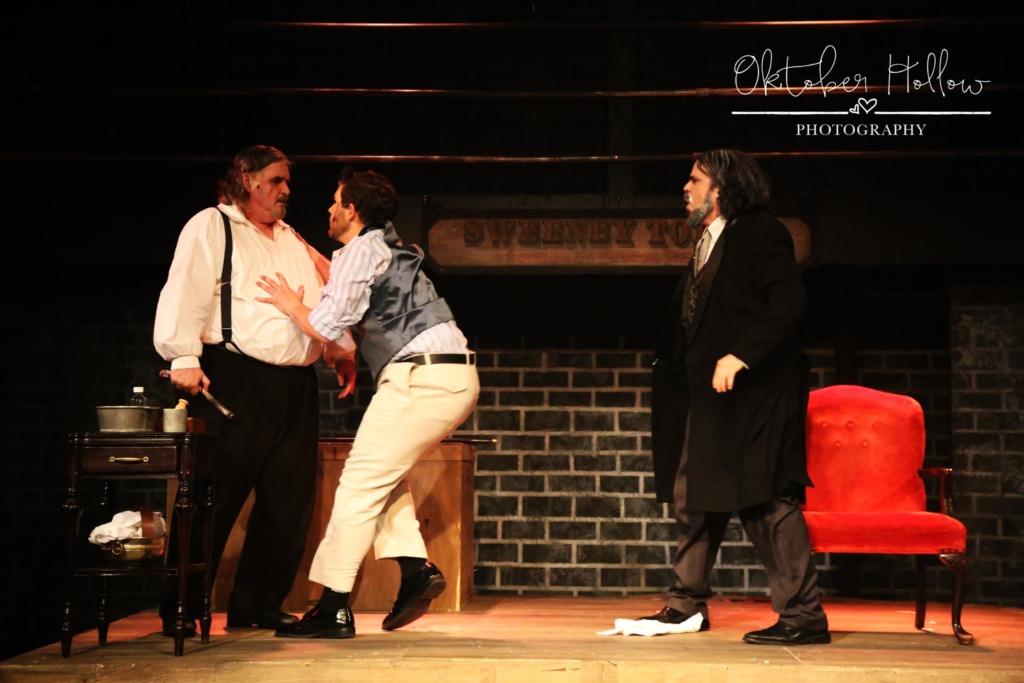
Their needs were few— the room was bare. Well, almost. Set Designer Lee Hebb dials back the physical construction of scenery in favor of a more minimalist approach to the production. The print-painted cobblestone floors and bricking on the walls gives you the ‘Londontown Vibes’ as well as the stunning smoky-silhouette mural (scenic artist Christine Levy) of the Londontown skyline painted on the entrance wall of the audiences’ seating area. There’s a second story catwalk that comes into play and visually, with the lit-lampposts attached to it, the effect is quite striking. A wooden platform stage sits center stage and helps to demarcate some of the play spaces within the show— the town square, the Tonsorial Parlor, Mrs. Lovette’s Pie Shop, the bake house— or at least that’s the intention. The spatial utility of the actors once their on stage doesn’t always follow consistently with how the space is arranged, but its only mildly distracting and easy enough to overlook. The infamous chair sits pride of place from its arrival at the top of Act II and its fully functional! The show’s sinister aesthetic comes tied together by the hands of Properties Mistress Jennifer Maschal-Lorms who is responsible not only for the ghastly meat pies, but the meat-grinder, ‘fresh meat’ splattered around it, and Sweeney’s iconic & bloody razors. Maschal-Lorms is also credited with the hair & makeup for the show, of which there is quite a bit adding to the fearful flavor of the show’s overall veneer.
Costumes are period appropriate, by way of Costume Designer Kirk Bower; you get a lot of high-waisted skirts for the ladies and crisp-pressed trousers on the gents. Johanna’s cupcake-topper dress gives her that extra push in the way of ‘winsome innocence’ and is featured during “Kiss Me”— you won’t be able to stop staring at all its floofy-poof layers (if you can take your eyes off of her and the highly animated, physically-engaging Anthony during that number.) There are little things that catch the eye— like the orange/pumpkin-print peasant blouse that Mrs. Lovette wears in one of her numbers, and the fact that Toby gets an almost identical top hat to his governor, Pirelli— the devil’s in the details, so they say— all functioning as little accents to note that the design is specific to Sweeney Todd a la OVT. It’s a simple costume piece, but that silver inlaid vest featured on Judge Turpin is one of the most impressive featured in the production.
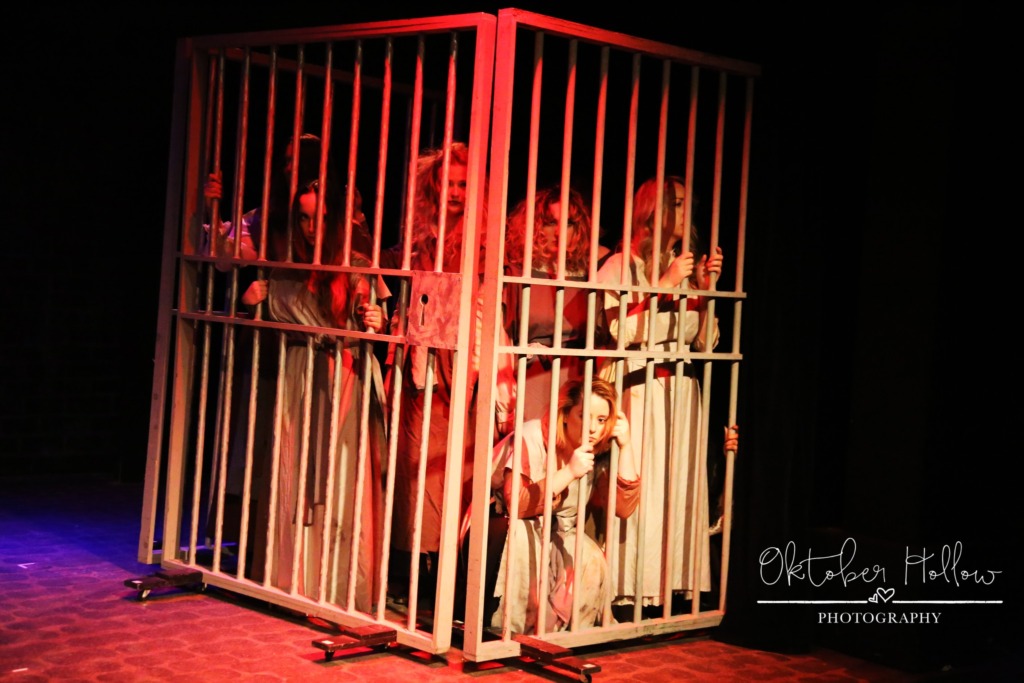
Musically the show is a bear. And not just the cute little black bears everyone’s been seeing around Frederick as of late, but a proper, behemoth grizzly that mauls at the ear and strikes with vengeance. Musical Director Paul Cabell has done an impressive job attempting to train the cast to be bear-wranglers. When the ensemble— Kelly Pannil Perkins, Annelyse Santos, Sarah Ward, Breton Stailey, Miranda Trautman, Carrie Meeder, Owen Paugh, Steven Saul, Abreana Porter, Kaitlyn McGuire, Dalton Korrell, Liz Curtis, Vanessa Furby— take to singing the various iterations of “The Ballad of Sweeney Todd”, you get some succinctly blended sounds that do service the score in a pleasing manner. The struggle with this particular production, as is the case for a great many theatres at the community level, is finding the balance between the canned music (not all theatres are fortunate enough to be able to afford a live pit orchestra or have the spatial requirements to house them during performance) and those singing on stage. Sound Designer Sean Hickey is still finding that balance. At present, the music often overwhelms some of the solo performers. (And who wouldn’t want to hear Sondheim’s insanely brilliant score, but it could stand to be dialed back liberally in this space so that the even more insanely brilliant lyrics that Sondheim has fabricated can be heard.) You lose some of the more profound lines— like Lovette’s expression near the very end of the show— and it’s a shame because the performers are working so very hard to articulate the verbiage soup that Sondheim has simmered into existence. As the show runs (three weekends, folks) perhaps Hickey will perfect the balance and the issue will resolve itself.
Pacing for the show tight. Director Amy Hebb keeps the scenes flowing, the ensemble moving quickly on and off— taking the few scenic elements that solidify locations like the pie shop, Fogg’s asylum, etc. with them as they swiftly enter and exit the stage. And there are some truly striking visionary moments in the performance— the one that immediately comes to mind is the dueling use of the female ensemble members who become the inmates at Fogg’s asylum. They sing “City on Fire” (rather than just The Beggar Woman alone) and collapse in one unified gesture, synchronized as they hit the floor and become the corpses of the sewers when Sweeney and Lovette are searching for Toby. It’s really striking in both its devised nature and its execution. Nearly forgot to mention Lighting Designer Chris McGuire, whose subtle and less-subtle uses of red splashes, tightly focused drop-spots, and other spooky effects really add a sense of foreboding and dread to certain moments throughout the performance as well. McGuire doesn’t go heavy-handed with the red, as productions of Sweeney are often wont to do, but rather finds the balance of when to use it as an accent and when to not use it so as not to overdo it. It sheds light on the production’s intentions as a whole and helps create the emotional tension that some of the musical numbers require to thrive.
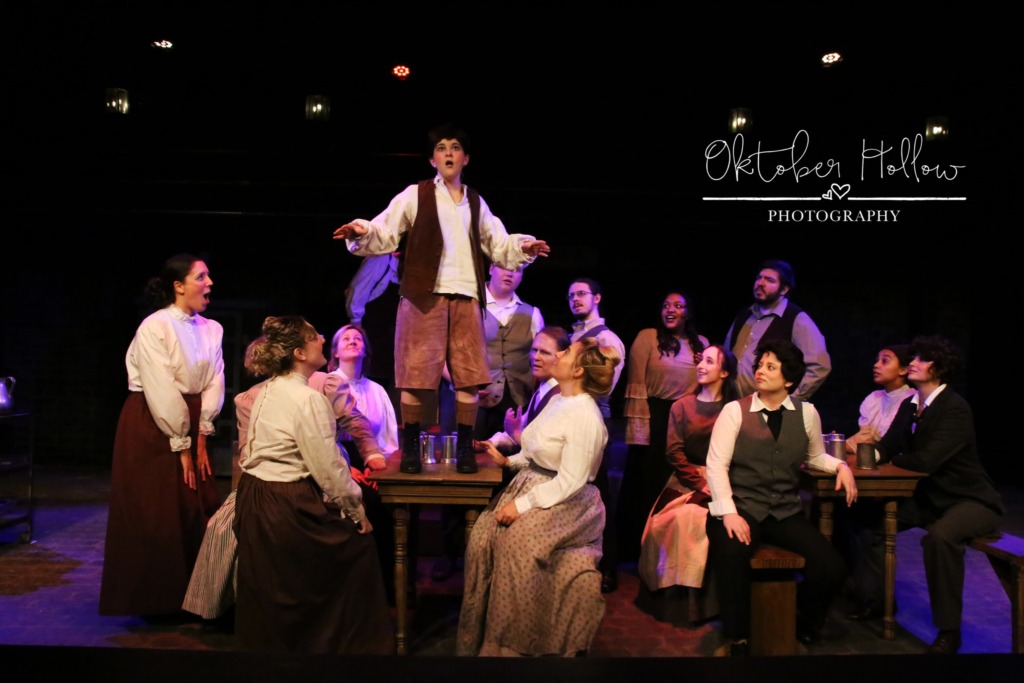
Director Amy Hebb also keeps the performance on its toes; she’s added back the infamous (officially named “Johanna”) number, which is being referred to in the production as “Mea Culpa.” While the spatial staging of it— featuring Judge Turpin (Andrew Shifler) as the song’s lone soloist— is smart (Hebb places Shifler up on the catwalk overlook, just one framing space over from Johanna) the songs feels slightly lacking. It’s hard to say why because Shifler sings it decently enough, and the intention of what he’s doing during the song is there, it just feels off somehow. And it’s difficult to explain what about it is off, though Hebb should get credit for daring to include it as the number is nearly always cut from performance. There’s an overarching sense of deadpan stiffness that slithers through this production and its also somewhat muddled as to whether this is an intentional choice for the production as a whole or if enough characters are choosing this vein of dry wit that it’s just reading like a dominant lens. There are definitely moments when the stiff deadpan works— like when Lovette has her little exchange at the end of Sweeney’s number, “Epiphany” but there are other moments, shared over multiple characters, where it just feels like an odd, or perhaps unfinished choice. The lyrics of the show feel as if they are crying out for more heightened bouts of physical comedy and expression (this could read as a very dark comedy) and the production as it stands feel as if it’s trying to get there but perhaps just hasn’t gotten there yet.
The Beadle (Kirk Bowers) has a simple and sweet voice, surprisingly high-tenor sound, which is well suited for the little parlor-room ditty that he sings when arriving at Lovette’s parlor and he makes for the perfect toady-stooge following around in Judge Turpin’s (Andrew Shifler)’s wake. The pair are seldom seen out of each other’s company, though when you do encounter Shifler’s Judge on his own, it is quite disturbing. Shifler brings a solid bari-bass range to “Pretty Women” and is indeed setting forth that ‘merry mood’ when he starts hum-bobbling his way through the number before Sweeney starts singing it and the pair go at the duet in unison.
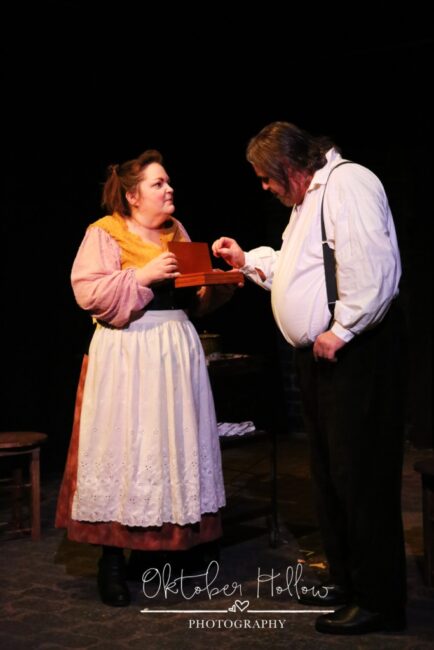
Sweeney was smooth, Sweeney was subtle…and Steve Cairns in the titular role, lives up to those lyrics. Not the choice you’d expect from a Sweeney Todd, but Cairns holds his own against the bombastically difficult score and lyrics which Sondheim has graciously gifted the title character. It’s almost like watching a zombie on autopilot, for the first good half of the show. There are moments where Cairns erupts to life, like a dormant volcano that suddenly and inexplicably explodes. You see this most profoundly at the very end of “Poor Thing” (Lovette’s number) where he bursts out of the dazed stupor of being back in London— it’s a fascinating transition to watch for those moments when it happens. Cairns really comes to life during “Epiphany” and you get the textbook growl and siege of the invisible forces of injustice that are frothing forth from the character in that moment. His voice is smooth and does glide not unlike a razor over “My Friends”, and you get the sense that he’s been around the block a time or three before when it comes to the trickier scansions of the score. He and Lovette (Karen Heyser Paone) really do their due diligence when it comes to “A Little Priest”, which becomes the hallmark number of this production. The pair find chemistry, balance, and hilarious humors that really do the pun-tastic nature of this number swift and steaming justice. Paone, as Mrs. Lovette, has a voice that is also suited for the score as written, and serves up a complete platter of ‘perpetually dead inside’ for the whole performance. An unusual choice that works well in some spots and reads with less solidarity in others but she sings the music well and gets the lyrics delivered in time with the music.
Johanna, Johanna, so suddenly a starlet; Jillian Wiley is bringing operatic quality sensationalism to the otherwise doe-eyed ingenue role. With a vibrato that can be heard all the way over in Baker Park from her catwalk on the set, Wiley is soaring through those top soprano notes like the Concord. If she has a fault its that at times the excitement of her character is so bubbly, so insanely perky and giddy that her lyrics (particularly during “Kiss Me”) jumble together, tripping over one another at lightning speed and you lose a bit of the finesse that Sondheim has penned. Her voice is extraordinary, perfect for “Green Finch and Linnet Birds” as well as all of her little duets with Anthony. Very reactive of face, very expressive— whether she’s shocked and abhorring the Judge or gushing with meet-cute-hormones over Anthony— you get a well-ground and fully rounded portrayal of a usually ‘relegated to the princess-side-track’ character from Wiley. What makes her so noticeable is the insane chemistry that she seems to share with Anthony (Ryan Kieft.) One of the most enjoyable moments in the show is the tongue-in-cheek ‘trashy-bodice-ripper-novel’ cover-art pose that the pair strikes at the end of the “Kiss Me Quartet”. You’ll see and hear a whole host of chaos happening in that number, this is a Sondheim show, after all, so the meet-cute moment, staged up on the catwalk-come-balcony is a sneaky, cheeky nod to the type of tawdry romance novels that often feature such ludicrous ‘love-lust-at-first-sight’ relationships. Again, devil’s in the details and this is one detail that is hilarious and impossible to overlook.
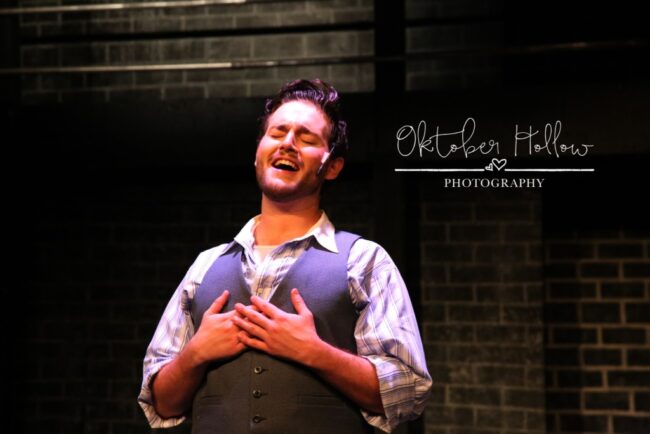
In this production, you almost get a different sense of the narrative as the Anthony character is so present and forward. While Lovette is delivering dead-inside and Sweeney is on auto-pilot-zombie-mode to display how much of his life has been ruined by circumstances out of his control, fresh-faced, eager-spirited Anthony is bouncing about with the naivete of the sprightly young sailor character that he is. Ryan Kieft has a voice that transcends the human psyche and spirit, which not only makes it a perfect marrying match for his duets with the operatic Jillian Wiley, but also for his solo numbers. When he sings “Ah, Miss” and “Johanna” you find yourself mesmerized and simply hypnotized by the emotional fortitude, glorious vocals, and overall command of stage presence that he delivers. Kieft is reactionary, responsive, and you simply cannot take your eyes off of him, even at the very end during “Epilogue: Ballad of Sweeney Todd” where he goes cold, dead, and fierce without so much as an eyebrow twitch (showcasing his impressive versatility as an actor.) There are even moments where his heightened sense of activity and response push the show in a slightly farcical direction, which adds some subtle humors to this dark and twisty tale. Ryan Kieft is spinning Anthony Hope: The Sprightly Sailor of Fleet Street and pedaling his experiences with Sweeney Todd, Johanna, and the rest in a remarkably felicitous fashion that has the audience falling over themselves to see, hear, and absorb more of him.
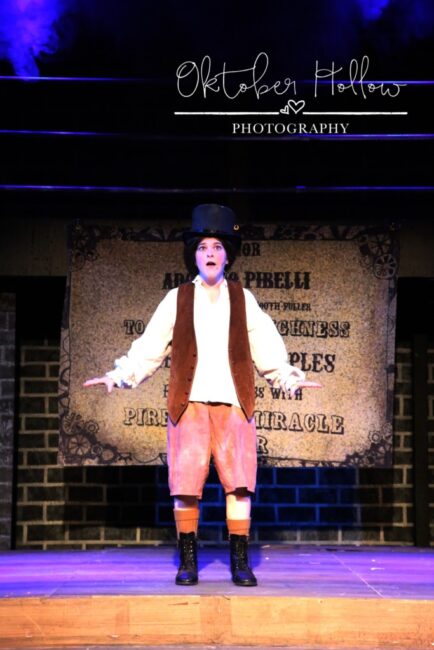
Stealing the show right out from under everyone’s noses is the plucky, spunky, and insanely talented Ainsley Deegan, playing little Tobias Ragg. Deegan’s vocal prowess is sensational, especially considering she’s just 17 years old. Working closely with musical director Paul Cabell, she performs magical singing acrobatics that work around the natural break in her vocal range so seamlessly that you don’t even notice the missing higher notes; it’s truly astonishing. Watch Deegan closely during “Pirelli’s Miracle Elixir” and note how her face fills with furious blushing when the crowd starts to turn on the Toby character and poor Toby begins to panic. She’s a radiant gem of a street urchin, there’s no question. Whether Deegan’s character is chasing The Beggar Woman (Denise O’Brien) out of Lovette’s shop during “God, That’s Good!” or racing to appease Pirelli (Mathew Withers) she’s got all eyes in the audience on her. Animated facial expressions, sincerity in her vocal delivery, even when singing “Nothing’s Going To Harm You”, a duet-scene with Lovette, you can’t take your eyes off of her. She’s a delightful scene-stealing, show-stopping imp, whose vocals rival that of Kieft and Wiley.
It’s not an easy task, tackling the mountain-bear-musical that is Sweeney Todd: The Demon Barber of Fleet Street. Other Voices Theatre has some truly remarkable performers delivering some wild moments on stage, they have solid grip on the score as an ensemble, and there are some stupefying moments that give you the giddy-darkness giggles. Playing for three weekends during spooky season, be sure to snag your tickets. We wouldn’t want you to end up being paid a visit by Mr. Todd for skipping out on the show, now would we?
Running Time: 2hours and 40 minutes with one intermission
Sweeney Todd: The Demon Barber of Fleet Street plays October 6th 2023 through October 22nd 2023 with Other Voices Theatre Other Voices Theatre at The Performance Factory— 244-B South Jefferson Street in Frederick, MD. Tickets are available by calling the box office at (301) 662-3722 or by purchasing them in advance online.
To read the tasty interview with members of the production, click here.
